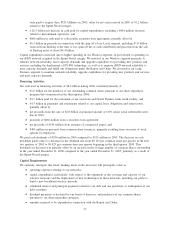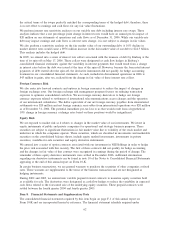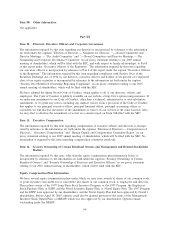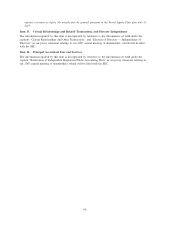Sprint - Nextel 2006 Annual Report Download - page 63
Download and view the complete annual report
Please find page 63 of the 2006 Sprint - Nextel annual report below. You can navigate through the pages in the report by either clicking on the pages listed below, or by using the keyword search tool below to find specific information within the annual report.The above discussion is subject to the risks and other cautionary and qualifying factors set forth under
“— Forward-Looking Statements” and in Part I, Item 1A “Risk Factors.”
Financial Strategies
General Risk Management Policies
We primarily use derivative instruments for hedging and risk management purposes. Hedging activities may be
done for various purposes, including, but not limited to, mitigating the risks associated with an asset, liability,
committed transaction or probable forecasted transaction. We seek to minimize counterparty credit risk through
stringent credit approval and review processes, credit support agreements, continual review and monitoring of
all counterparties, and thorough legal review of contracts. We also control exposure to market risk by regularly
monitoring changes in hedge positions under normal and stress conditions to ensure they do not exceed
established limits.
Our board of directors has adopted a financial risk management policy that authorizes us to enter into
derivative transactions, and all transactions comply with the policy. We do not purchase or hold any derivative
financial instruments for speculative purposes with the exception of equity rights obtained in connection with
commercial agreements or strategic investments, usually in the form of warrants to purchase common shares.
Item 7A. Quantitative and Qualitative Disclosures about Market Risk
We are primarily exposed to the market risk associated with unfavorable movements in interest rates, foreign
currencies and equity prices. The risk inherent in our market risk sensitive instruments and positions is the
potential loss arising from adverse changes in those factors.
Interest Rate Risk
The communications industry is a capital intensive, technology driven business. We are subject to interest rate
risk primarily associated with our borrowings. Interest rate risk is the risk that changes in interest rates could
adversely affect earnings and cash flows. Specific interest rate risk include: the risk of increasing interest rates
on short-term debt; the risk of increasing interest rates for planned new fixed rate long-term financings; and
the risk of increasing interest rates for planned refinancing using long-term fixed rate debt.
Cash Flow Hedges
We enter into interest rate swap agreements designated as cash flow hedges to reduce the impact of interest
rate movements on future interest expense by effectively converting a portion of our floating-rate debt to a
fixed-rate. As of December 31, 2006, we had no outstanding interest rate cash flow hedges.
Fair Value Hedges
We enter into interest rate swap agreements to manage exposure to interest rate movements and achieve an
optimal mixture of floating and fixed-rate debt while minimizing liquidity risk. The interest rate swap
agreements designated as fair value hedges effectively convert our fixed-rate debt to a floating-rate by
receiving fixed rate amounts in exchange for floating rate interest payments over the life of the agreement
without an exchange of the underlying principal amount. As of December 31, 2006, we had outstanding
interest rate swap agreements that were designated as fair value hedges.
About 95% of our debt as of December 31, 2006 was fixed-rate debt excluding interest rate swaps. While
changes in interest rates impact the fair value of this debt, there is no impact to earnings and cash flows
because we intend to hold these obligations to maturity unless market and other conditions are favorable.
As of December 31, 2006, we held fair value interest rate swaps with a notional value of $1.0 billion. These
swaps were entered into as hedges of the fair value of a portion of our senior notes. These interest rate swaps
have maturities ranging from 2008 to 2012. On a semiannual basis, we pay a floating rate of interest equal to
the six-month LIBOR plus a fixed spread and receive an average interest rate equal to the coupon rates stated
on the underlying senior notes. On December 31, 2006, the rate we would pay averaged 8.3% and the rate we
would receive was 7.2%. Assuming a one percentage point increase in the prevailing forward yield curve, the
fair value of the interest rate swaps and the underlying senior notes would change by $28 million. These
interest rate swaps met all the requirements for perfect effectiveness under derivative accounting rules as all of
61
























